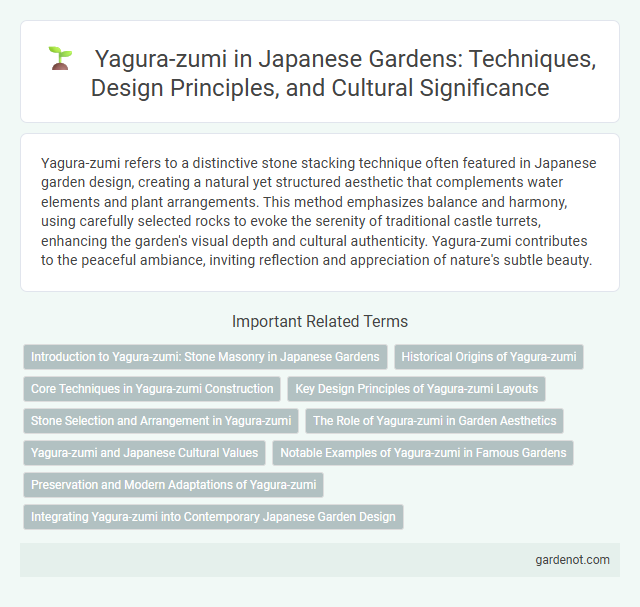Yagura-zumi refers to a distinctive stone stacking technique often featured in Japanese garden design, creating a natural yet structured aesthetic that complements water elements and plant arrangements. This method emphasizes balance and harmony, using carefully selected rocks to evoke the serenity of traditional castle turrets, enhancing the garden's visual depth and cultural authenticity. Yagura-zumi contributes to the peaceful ambiance, inviting reflection and appreciation of nature's subtle beauty.
Introduction to Yagura-zumi: Stone Masonry in Japanese Gardens
Yagura-zumi refers to a traditional stone masonry technique used in Japanese gardens to create sturdy, aesthetically pleasing retaining walls and garden structures. This method involves carefully stacking irregularly shaped stones without mortar, emphasizing natural texture and harmony with the surrounding landscape. Its engineering not only ensures durability but also reflects the elegance and simplicity central to Japanese garden design.
Historical Origins of Yagura-zumi
Yagura-zumi, a traditional Japanese masonry technique, originated during the Sengoku period (15th-17th centuries) as a method for constructing durable castle walls and fortifications. This technique involves stacking large, irregularly shaped stones without mortar, relying on precise fitting and gravity to ensure stability and resilience. Its application in garden design reflects a historical connection to samurai culture and the architectural ingenuity of feudal Japan.
Core Techniques in Yagura-zumi Construction
Yagura-zumi construction employs precise stacking and interlocking of stones to create durable and stable walls typical of traditional Japanese gardens. Core techniques include selecting stones by size and shape to ensure balance and using minimal mortar for a natural appearance while maintaining structural integrity. Strategic placement of base stones supports weight distribution, preventing collapse and enhancing long-term resilience.
Key Design Principles of Yagura-zumi Layouts
Yagura-zumi layouts in Japanese gardens emphasize asymmetry, balance, and natural integration, creating visually compelling stone arrangements that mimic natural rock formations. The strategic placement of stones follows the principle of "wa" (harmony), enhancing spatial depth and promoting a tranquil atmosphere. Key elements include varying stone sizes, textures, and orientations to evoke a seamless connection between human design and nature.
Stone Selection and Arrangement in Yagura-zumi
Yagura-zumi stone selection emphasizes durability, texture, and color harmony to reflect natural landscapes authentically. Stones are meticulously arranged in layered, overlapping formations to create visual depth and structural stability characteristic of traditional Japanese gardens. This arrangement technique enhances aesthetic balance while symbolizing strength and resilience within garden design.
The Role of Yagura-zumi in Garden Aesthetics
Yagura-zumi, the traditional Japanese stone wall technique, enhances garden aesthetics by creating harmonious balance between natural elements and structural design. Its interlocking stones provide both functional support and a visually pleasing texture that complements the garden's tranquil ambiance. This method reflects the Wabi-Sabi principle, emphasizing rustic simplicity and the beauty of imperfection in Japanese gardens.
Yagura-zumi and Japanese Cultural Values
Yagura-zumi is a traditional Japanese stone stacking technique used in garden design to create naturalistic rock formations symbolizing strength and stability, reflecting core Japanese cultural values of harmony and balance with nature. This method emphasizes the meticulous placement of stones without mortar, showcasing craftsmanship and the aesthetic principle of wabi-sabi, which finds beauty in imperfection and impermanence. The presence of Yagura-zumi in Japanese gardens embodies a spiritual connection to the earth and the philosophical importance of simplicity and tranquility in Japanese culture.
Notable Examples of Yagura-zumi in Famous Gardens
Yagura-zumi, a distinctive stacked stone technique, is prominently featured in renowned Japanese gardens such as Kenrokuen in Kanazawa and Ritsurin Garden in Takamatsu. These gardens showcase Yagura-zumi walls that blend natural stone textures with architectural precision, enhancing the serene and harmonious atmosphere characteristic of traditional Japanese landscaping. The use of Yagura-zumi at these sites exemplifies the skillful integration of stone construction into garden design, emphasizing balance and historical authenticity.
Preservation and Modern Adaptations of Yagura-zumi
Yagura-zumi, the traditional Japanese dry stone wall technique, is rigorously preserved through meticulous restoration projects in historic gardens and cultural heritage sites. Modern adaptations incorporate sustainable materials and seismic-resistant design principles, enhancing both durability and environmental harmony. These efforts ensure that yagura-zumi remains a vital element of Japanese garden architecture while meeting contemporary safety standards.
Integrating Yagura-zumi into Contemporary Japanese Garden Design
Yagura-zumi, a traditional Japanese stone stacking technique, enhances contemporary Japanese garden design by blending historical craftsmanship with modern aesthetics. Incorporating Yagura-zumi creates authentic focal points that embody both structural strength and visual harmony. This approach promotes cultural continuity while adapting to minimalist and naturalistic trends in current garden architecture.
Yagura-zumi Infographic

 gardenot.com
gardenot.com